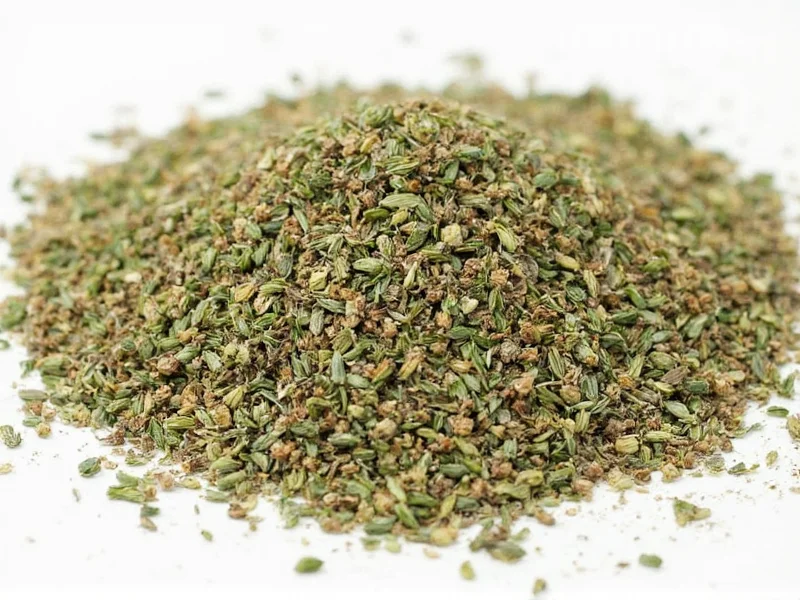The standard conversion ratio for dried thyme substitute for fresh is 1:3—use 1 teaspoon of dried thyme for every 1 tablespoon of fresh thyme required in your recipe. This accounts for dried thyme's more concentrated flavor profile due to moisture removal during the drying process.
Understanding proper herb substitution ratios makes the difference between a perfectly seasoned dish and a culinary disappointment. When you're mid-recipe and realize you're out of fresh thyme, knowing the correct dried thyme substitute for fresh measurement prevents recipe failure. This guide provides professional kitchen-tested conversions and alternative options when neither form is available.
Why Dried and Fresh Thyme Require Different Measurements
Thyme loses approximately 70-80% of its weight during the drying process as moisture evaporates. This concentration effect means dried thyme delivers more intense flavor compounds per volume than its fresh counterpart. The essential oils responsible for thyme's distinctive earthy, slightly minty flavor become more potent when water content decreases.
Professional chefs universally follow the 1:3 ratio because it accounts for this concentration difference. Using equal amounts would result in overpowering, potentially bitter flavors that dominate your dish rather than complementing other ingredients.
Best Dried Thyme Substitutes for Fresh Measurements
When your recipe calls for fresh thyme but you only have dried, these conversions ensure balanced seasoning:
| Recipe Requires | Dried Thyme Substitute | Best For |
|---|---|---|
| 1 tablespoon fresh | 1 teaspoon dried | All cooking applications |
| 1 sprig fresh | 1/4 teaspoon dried | Simmered dishes (stews, soups) |
| 1/4 cup fresh | 3 teaspoons (1 tablespoon) dried | Roasts, braises, marinades |
Alternative Substitutes When Neither Form Is Available
If you lack both fresh and dried thyme, these herb alternatives work in various culinary contexts. Remember that each brings its own flavor profile, so choose based on your dish type:
- Oregano - Use 3/4 the amount of thyme called for; ideal for Mediterranean dishes and tomato-based recipes
- Marjoram - Substitute equal amounts; milder than thyme, perfect for delicate sauces and poultry
- Rosemary - Use half the amount; strong pine flavor works well with roasted meats but overpowering in subtle dishes
- Herbes de Provence - Substitute equal amounts; contains thyme plus complementary herbs
- Savory - Use equal amounts; peppery flavor suits bean dishes and stuffings
When to Adjust the Standard Ratio
While the 1:3 dried thyme substitute for fresh ratio works for most applications, consider these adjustments:
- Long-cooking dishes (stews, braises): Reduce dried thyme by 25% since flavors intensify over time
- Delicate dishes (fish, custards): Use 3/4 teaspoon dried per tablespoon fresh to prevent overpowering
- Raw applications (salad dressings, garnishes): Increase fresh thyme by 25% when substituting dried, as heat activates dried herb flavors
- Old dried thyme (over 1 year): Increase by 25-50% as potency diminishes with age
Proper Storage for Maximum Flavor Retention
To maintain optimal flavor when using dried thyme as fresh substitute:
- Store dried thyme in airtight containers away from light and heat
- Whole dried leaves retain potency 6 months longer than crushed
- Test potency by rubbing between fingers—strong aroma indicates freshness
- Freeze fresh thyme sprigs in olive oil for later use as fresh substitute
Common Substitution Mistakes to Avoid
Prevent flavor disasters with these practical tips for dried thyme substitute for fresh conversions:
- Don't substitute equal volumes - This creates overwhelmingly strong flavors
- Avoid adding dried herbs late in cooking - They need 15-20 minutes to rehydrate and release flavors
- Don't crush dried thyme between fingers - This releases oils too quickly, causing flavor loss
- Never substitute dried for fresh in garnishes - Dried herbs look unappetizing raw
Professional Chef Recommendations
Top culinary professionals emphasize these principles when working with dried thyme substitute for fresh measurements:
“Always bloom dried thyme in hot oil for 30 seconds before adding other ingredients. This rehydrates the herb and unlocks its full flavor potential, bringing it closer to fresh thyme's profile.” — Chef Michael Solomonov, Zahav
“When substituting dried for fresh in baking applications, reduce the amount by 10-15% because oven heat intensifies dried herb flavors.” — Chef Dominique Ansel, Dominique Ansel Bakery
Flavor Profile Comparison Chart
| Herb Form | Flavor Intensity | Best Cooking Applications | Shelf Life |
|---|---|---|---|
| Fresh thyme | Mild, grassy, floral notes | Garnishes, finishing, delicate sauces | 2 weeks refrigerated |
| Dried thyme | Concentrated, earthy, slightly bitter | Long-cooking dishes, rubs, marinades | 1-3 years stored properly |
| Frozen thyme | Nearly identical to fresh | All applications except garnishes | 6-12 months |
Practical Application Guide
Use this quick reference when determining dried thyme substitute for fresh measurements in specific dishes:
- Roasted chicken: 1 tsp dried thyme per chicken (substitutes 3 tbsp fresh)
- Tomato sauce: 1/2 tsp dried thyme per quart (substitutes 1.5 tbsp fresh)
- Vegetable soup: 3/4 tsp dried thyme per pot (substitutes 2.25 tbsp fresh)
- Salad dressing: 1/4 tsp dried thyme per cup (substitutes 3/4 tbsp fresh)
- Meatloaf: 1/2 tsp dried thyme per pound (substitutes 1.5 tbsp fresh)











 浙公网安备
33010002000092号
浙公网安备
33010002000092号 浙B2-20120091-4
浙B2-20120091-4